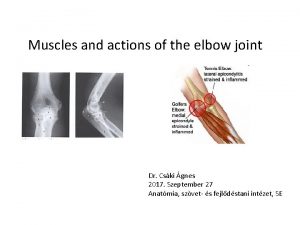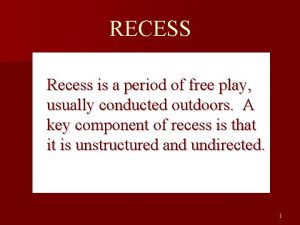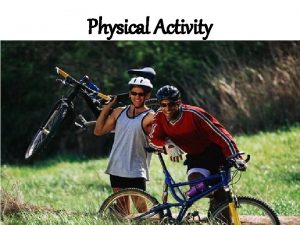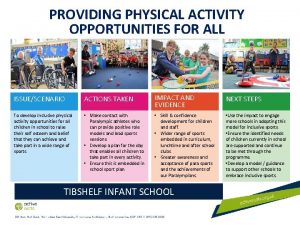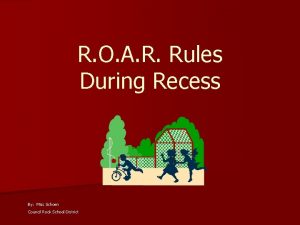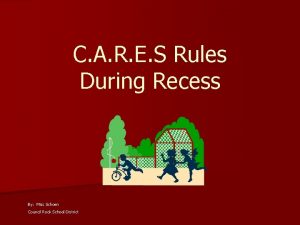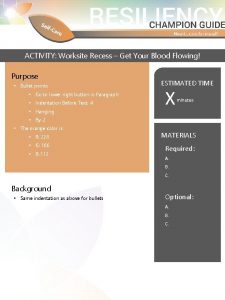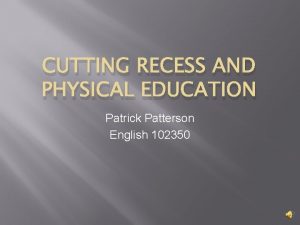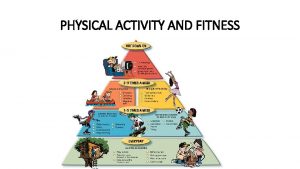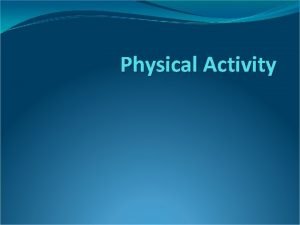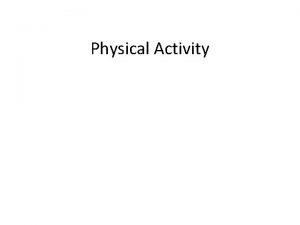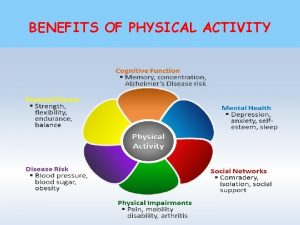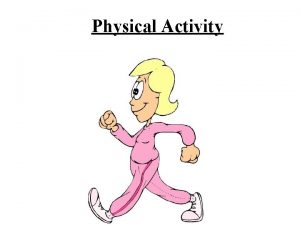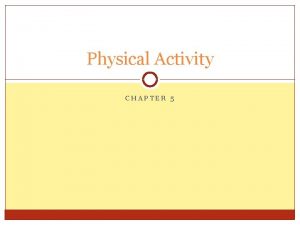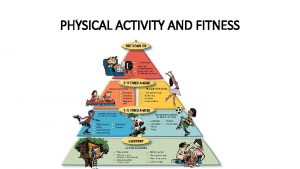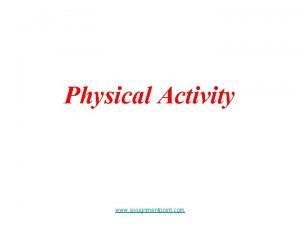Physical Activity During School Providing Recess to All




























- Slides: 28

Physical Activity During School: Providing Recess to All Students 1

Purpose • Explain how recess supports student success. • Share three new resources for recess • Strategies for Recess in Schools • Recess Planning in Schools: A Guide to Putting Strategies for Recess into Practice • Recess Planning Template • Learn how to support recess in schools. 2

Whole School, Whole Community, Whole Child Model 3

Physical Education and Physical Activity 4

Definition of Recess • A regularly scheduled period within the school day for physical activity and play that is monitored by trained staff or volunteers. • Recess is a period of time when students are encouraged to be physically active and engaged with their peers in activities of their choice, at all grade levels, kindergarten through 12 th grade. 5

Benefits of Recess • Improves social and emotional development. • Improves memory, attention, and concentration. • Helps students stay on-task in the classroom. • Reduces disruptive behavior in the classroom. • Increases level of physical activity. 6

National Guidance for Recess • Provide all students K‒ 12 with at least 20 minutes of recess daily. • Prohibit the replacement of physical education with recess. • Provide schools and students with adequate spaces, facilities, equipment, and supplies for recess. • Ensure that spaces and facilities for recess meet or exceed recommended safety standards. • Prohibit the exclusion of students from recess for disciplinary reasons or academic performance in the classroom. • Prohibit the use of physical activity during recess as punishment. • Provide recess before lunch. • Provide staff members who lead or supervise recess with ongoing professional development. Source: CDC and SHAPE America—Society of Health and Physical Educators. Strategies for Recess in Schools. Atlanta, GA: Centers for Disease Control and Prevention, US Dept of Health and Human Services; 2017. 7

Recess Participation Percentage of Elementary Schools that Had Students Participate in Regularly Scheduled Recess During the School Day* Kindergarten 95% 1 st Grade 95% 2 nd Grade 95% 94% 3 rd Grade 4 th Grade 93% 5 th Grade 91% 6 th Grade 35% *Among elementary schools with students in that grade. Source: CDC. Results from the School Health Policies and Practices Study 2014. Atlanta, GA. US Department of Health and Human Services; 2015. 8

Recess: Number of Days and Minutes* • On average, schools schedule students to have recess 5 days a week. • On average, schools have students spend 27 minutes in recess each day. YES! Meets the national guidance for recess, but we still have schools not offering recess! *Among elementary schools in which students participate in regularly scheduled recess. Source: CDC. Results from the School Health Policies and Practices Study 2014. Atlanta, GA. : US Department of Health and Human Services; 2015. 9

Recess Policy on Punishment • 54% of elementary schools prohibited or actively discouraged staff from excluding students from all or part of recess as punishment for: • Bad behavior. • Failure to complete class work. Source: CDC. Results from the School Health Policies and Practices Study 2014. Atlanta, GA. : U. S. Department of Health and Human Services; 2015. ` 10

Students Can’t Go Outside for Recess • 100% of elementary schools hold recess outdoors, weather permitting. • But when schools can’t let students go outside: 40% have students engage in other sedentary activities, such as board games 30% have students participate in physical activity in the gym, multi-purpose room, or cafeteria 18% have students participate in physical activity in regular classrooms 6% have students watch a DVD or video Note: Percent in bubbles reflect the percentage of elementary schools. Source: CDC. Results from the School Health Policies and Practices Study 2014. Atlanta, GA: US Department of Health and Human Services; 2015. 11

Using Safety Checklist and Posting Rules • 97% of elementary schools have playground facilities and equipment. • 49% of elementary schools use the safety checklist and equipment guidelines published in the Public Playground Safety Handbook. • 49% of elementary schools post rules for the safe use of specific types of playground equipment. Source: CDC. Results from the School Health Policies and Practices Study 2014. Atlanta, GA: U. S. Department of Health and Human Services; 2015. 12

Physical Activity in Middle and High Schools Physical Activity Practice in Schools* Middle Schools High Schools Have students participate in regular physical activity breaks during the school day 64% 27% Have a specified time or event for schoolwide physical activity 34% 14% *During the school day outside of physical education class. Source: CDC. Results from the School Health Policies and Practices Study 2014. Atlanta, GA: U. S. Department of Health and Human Services; 2015. 13

14

Strategies for Recess in Schools 15

Strategies for Recess in Schools Category 1: Make Leadership Decisions 1. Identify and document recess policies. 2. Put documented recess policies into practice and revise as needed. 3. Develop a written recess plan. 4. Designate spaces for outdoor and indoor recess. 5. Establish weather guidelines to ensure student safety. 6. Train school staff and volunteers for recess. 16

Strategies for Recess in Schools Category 2: Communicate and Enforce Behavioral and Safety Expectations 7. Establish and communicate behavior management strategies. 8. Teach conflict resolution skills. 9. Ensure that recess spaces and facilities meet recommended safety standards. 17

Strategies for Recess in Schools Category 3: Create an Environment Supportive of Physical Activity During Recess 10. Provide adequate physical activity equipment. 11. Add markings to playground or physical activity areas. 12. Create physical activity zones. 13. Provide planned activities or activity cards. 14. Provide a combination of recess strategies. 18

Strategies for Recess in Schools Category 4: Engage the School Community to Support Recess 15. Establish roles and responsibilities for supervising and facilitating recess. 16. Involve students in planning and leading recess. 17. Mobilize parents and others in the school community to support and sustain recess at school. 19

Strategies for Recess in Schools Category 5: Gather Information on Recess 18. Track physical activity during recess. 19. Collect information on recess to show the effect on student and school outcomes. 20

21

Using the Planning Guide • Use questions to identify what is currently in place. • Discuss and select strategies to strengthen recess. • Document how schools will implement the strategies. • Identify relevant resources. 22

Planning Guide Template • Document the customized school recess plan. • Identify how school will implement recess. • Communicate recess plan with school community. 23

Footsteps on a Playground at Recess 24

Take Action • Educate the school community about the benefits of daily recess. • Include recess in the local school wellness policy. • Know the 19 evidence-based strategies in the Strategies for Recess in Schools. • Use the Recess Planning in Schools guide to develop a written school recess plan. 25

Additional Information 26

Questions 27

Thank You! • List speakers and contact information. For more information, contact the Centers for Disease Control and Prevention: Visit www. cdc. gov/healthyschools/ Contact CDC-INFO at www. cdc. gov/cdc-info Call 1 -800 -CDC-INFO (232 -4636); TTY: 1 -888 -232 -6348 28
 What is physical fitness test in mapeh
What is physical fitness test in mapeh Draw three noncollinear points j k and l
Draw three noncollinear points j k and l Round window vs oval window
Round window vs oval window Suprapleural membrane
Suprapleural membrane Pleura lungs
Pleura lungs Humeroulnar joint
Humeroulnar joint Recess in engineering drawing
Recess in engineering drawing Recess in engineering drawing
Recess in engineering drawing The drive which is used for metal cutting
The drive which is used for metal cutting Blind hole symbol
Blind hole symbol Ligament of the stomach
Ligament of the stomach Peritoneal sac
Peritoneal sac Ligamentum teres
Ligamentum teres Left colic flexure
Left colic flexure Tensor tympani
Tensor tympani Costomediastinal recess
Costomediastinal recess Acoustic meatus
Acoustic meatus 3 parts of duodenum
3 parts of duodenum 562x90
562x90 Pharyngeal recess
Pharyngeal recess Tubotympanic recess
Tubotympanic recess Thyroid pharyngeal pouch
Thyroid pharyngeal pouch Foramen omentale
Foramen omentale Omuz kol kompleksi
Omuz kol kompleksi Superior meatus
Superior meatus Recess time
Recess time Cooperative games in physical education
Cooperative games in physical education Dr. rezaeian
Dr. rezaeian Gait phases
Gait phases





